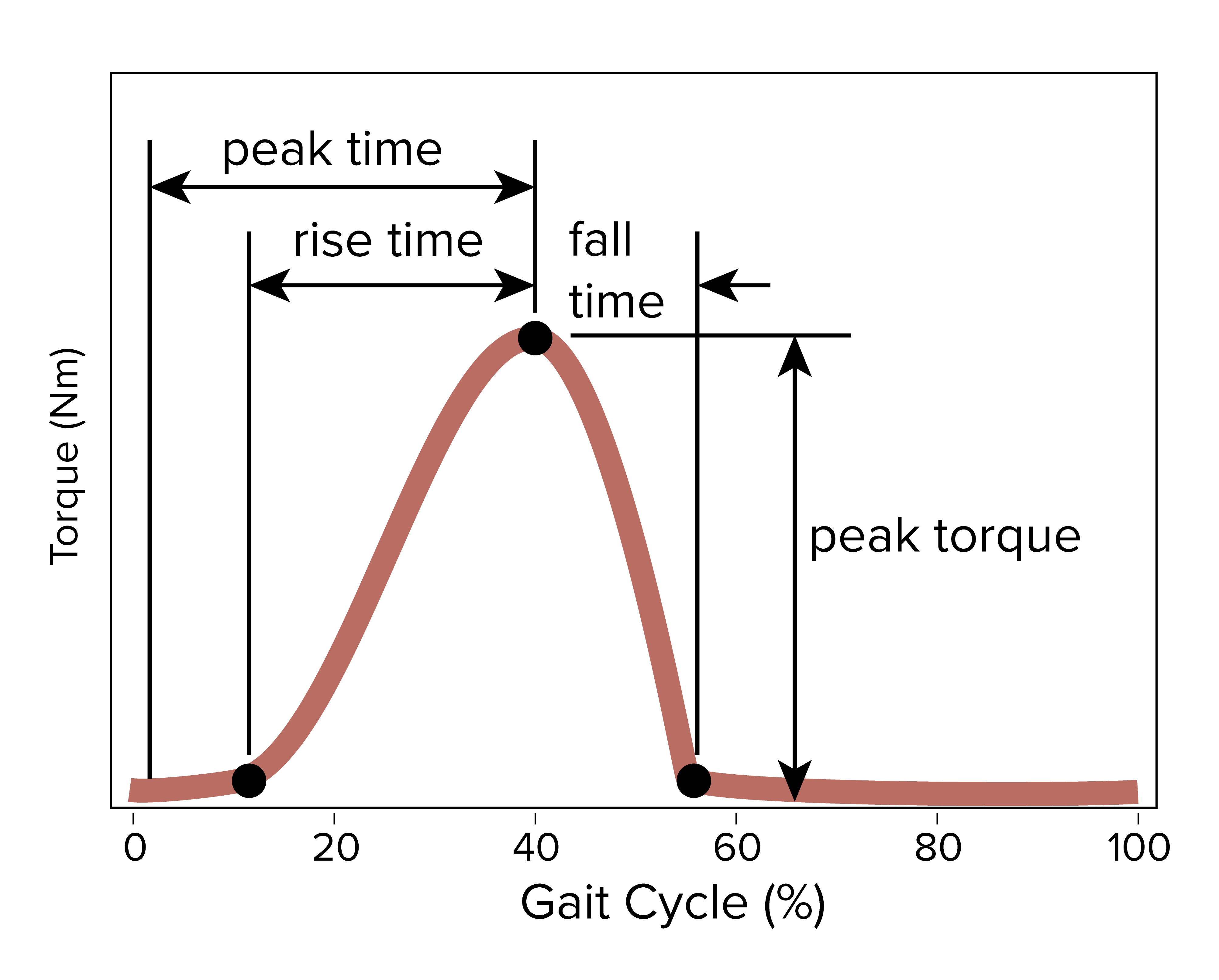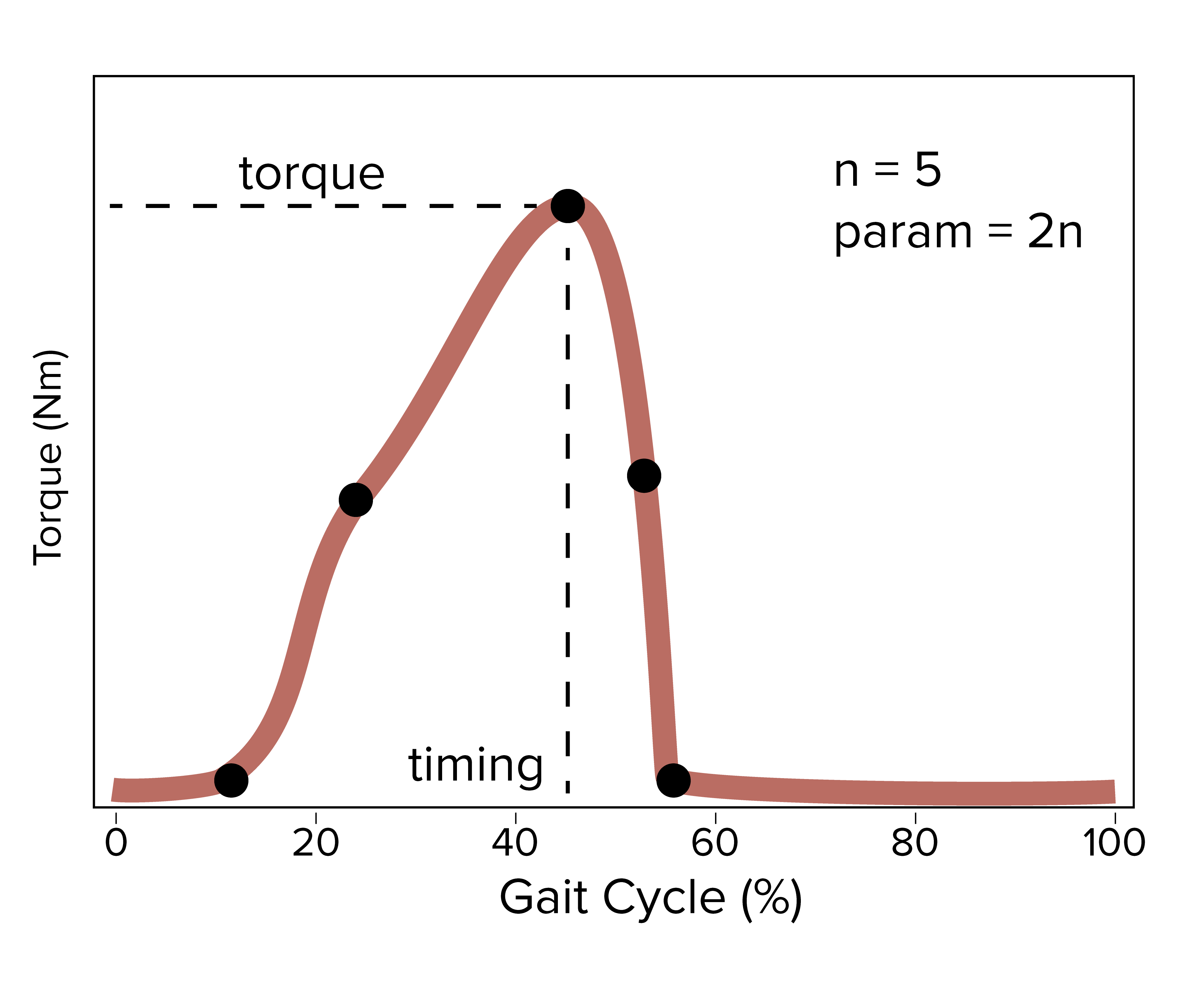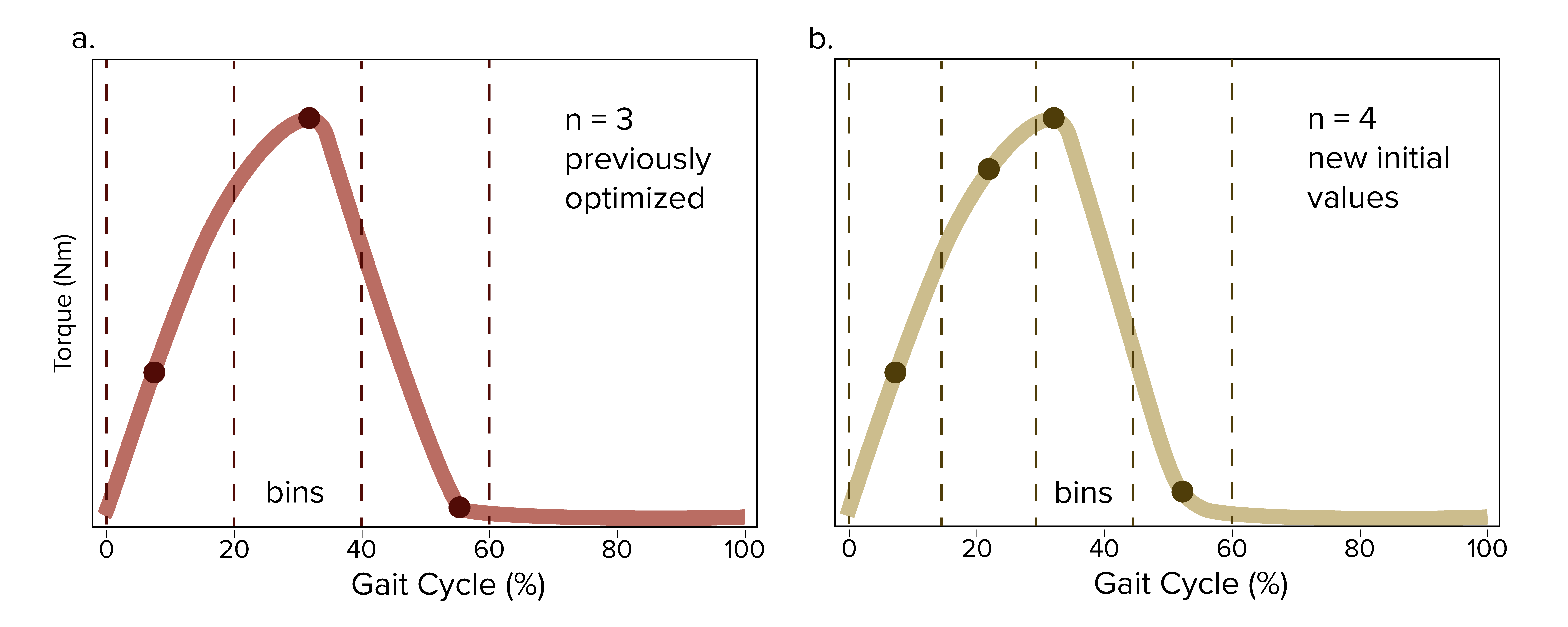Exoskeleton Controllers
This document details the architecture, implementation, and optimization of the provided exoskeleton controllers within the MyoAssist Reflex framework.
Overview
Each exoskeleton’s torque profile is governed by one of two spline-based controllers that are active during the stance phase of the gait cycle. The parameters of these controllers are optimized alongside the neuromuscular reflex parameters by the CMA-ES algorithm (Running Optimizations).
1. Actuator Definition
Each exoskeleton is defined as an actuator within the MuJoCo .xml model. There are multiple actuator types available within MuJoCo (Modeling). This actuator is what allows the framework to apply torque to the model.
Here is an example:
<general biasprm="0 0 0" gainprm="100 0 0" dynprm="1 0 0" biastype="none" gaintype="fixed" dyntype="none" joint="ankle_angle_r" name="Exo_R" gear="1.0" ctrlrange="-1 0" ctrllimited="true"/>
<general biasprm="0 0 0" gainprm="100 0 0" dynprm="1 0 0" biastype="none" gaintype="fixed" dyntype="none" joint="ankle_angle_l" name="Exo_L" gear="1.0" ctrlrange="-1 0" ctrllimited="true"/>
Two key attributes are:
joint: This specifies which joint the actuator acts upon (e.g.,ankle_angle_r).name: This provides a unique identifier for the actuator (e.g.,Exo_R).
The reflex_interface.py script uses the actuator’s name to identify it and apply the calculated torque to the correct entry in the simulation’s control vector (env.sim.data.ctrl).
2. Controller Architecture
Both provided controllers share a common architecture:
- Finite-State Machine (FSM): A simple FSM determines if the leg is in a “STANCE” or “SWING” state based on a vertical ground reaction force (vGRF) threshold.
- Stance Phase Tracking: When the leg is in “STANCE”, the controller tracks the elapsed time.
- Torque Spline: The torque profile is defined by a PCHIP (Piecewise Cubic Hermite Interpolating Polynomial) spline. The input to the spline is the current percentage of the stance phase (0-100%), and the output is the torque to be applied.
- Stance Duration Averaging: To normalize the stance phase percentage, the controller maintains a running average of the duration of the last three stances.
NOTE: Both controllers operate on the basis of normalized stance percentage (heel strike to toe off) rather than full normalized gait cycle, while the figures shown represent the full normalized gait cycle.
Controller A: 4-Parameter Spline (fourparam_spline_ctrl.py)
This is a version of a widely used controller defined by four parameters that describe the shape of a single torque pulse.
- Parameters:
peak_torque: The magnitude of the torque pulse (normalized 0-1, then scaled bymax_torque).rise_time: The time it takes to ramp up to peak torque (as a % of stance).peak_time: The point in the stance phase where the peak torque occurs (as a % of stance).fall_time: The time it takes to ramp down to zero torque after the peak (as a % of stance).
- Fixed Controller (
--fixed_exo): This command-line option allows the 4-parameter controller to be used with a fixed, predefined set of initial parameters instead of being optimized. This is useful for evaluating a known, static assistance profile.

4 parameter phase-based spline control
Controller B: N-Point Spline (npoint_spline_ctrl.py)
This is a more flexible controller that defines the torque profile using a variable number of control points.
- Parameters: The controller is defined by
2 * nparameters, wherenis the number of points (--n_points).n torqueparameters: The torque value at each control point (normalized 0-1).n timingparameters: The temporal position of each control point (normalized 0-1).

n-parameter spline control
3. Integration and Optimization
Parameter Bounds and Initialization
- Bounds (
bounds.py): The optimization bounds for all exoskeleton parameters (both torque and timing) are normalized to a[0, 1]range. This provides a consistent and well-behaved search space for the CMA-ES optimizer. - Initial Parameters (
train.py): When a new optimization is started (i.e., not from a--param_path), the initial exoskeleton parameters are set to predefined defaults:- 4-Parameter Controller: The initial shape is based on human-in-the-loop experiments from previous studies (Poggesnsee & Collins 2021), providing a good starting point for optimization.
peak_torque: 0.5rise_time: 0.467peak_time: 0.90fall_time: 0.075
- N-Point Controller: The initialization uses two key strategies:
- Torque Values (
utils/npoint_torque.py): Initial values follow a geometric decay pattern where peak torque (0.5 x peak_torque) is placed at or just after the middle point. Surrounding points decrease by powers of two based on distance from peak (i.e., with 4 points:[0.125, 0.25, 0.5, 0.25]). - Timing Values: Uses a segmented normalization approach: Divides stance phase into
nequal segments (e.g., forn=4: [0-25%], [25-50%], [50-75%], [75-100%]) where each timing parameter is normalized to[0, 1]within its segment. This segmentation, or “binning”, prevents parameter clustering and CMA-ES destabilization.
- Torque Values (
- 4-Parameter Controller: The initial shape is based on human-in-the-loop experiments from previous studies (Poggesnsee & Collins 2021), providing a good starting point for optimization.
Simulation Interfacing
- Interface (
reflex_interface.py): ThemyoLeg_reflexclass is the core integrator. It instantiates the chosen exoskeleton controller (FourParamSplineControllerorNPointSplineController) based on the command-line arguments. - Torque Application: During each step of the simulation, the interface calls the controller’s
.update()method to get the current torque value and applies it to the correct ankle joint actuator. - Spline Validity Check: The interface includes a crucial safety check,
check_spline_validity(). This function is called before evaluating the cost. It ensures that the timing parameters for the spline are monotonically increasing (i.e.,time_1 < time_2 < ... < time_n). If the order is invalid, the simulation is assigned a high penalty cost, preventing the optimizer from exploring unstable regions.
4. Continued Optimization and Bootstrapping
The framework provides two options for continuing or refining previous optimizations, with some additional logic for the n-point controller. This is handled via the --param_path argument in train.py (Running Optimizations).
Standard Continued Optimization
If you provide a --param_path to an optimization result that used the same number of exoskeleton parameters as your new optimization, the framework simply loads the parameters and continues optimizing from that point. This will always be true for the 4param controller and only true for the npoint controller if the same npoints value is passed. The same logic applies if you load human-only parameters for a new optimization with an exoskeleton; the framework will initialize the specified number of exo parameters with their default values and append them.
N-Point Bootstrapping Logic
A more complex option within the framework is the bootstrapping capability for continued npoint optimizations. This is triggered only when you use --param_path to load a result with a different number of n-points than your new optimization specifies (--n_points value). This allows you to, for example, find a good general torque shape with a 3-point controller and then refine it with a higher value n-point controller without starting from scratch.
- Process:
- The script loads the human parameters and the old
n-pointexo parameters. - It reconstructs the old PCHIP spline from the loaded parameters.
- It finds the absolute peak of this old spline.
- It generates a new set of new
n timingparameters, spaced accordingly. - It evaluates the old spline at these new timing points to get the corresponding initial torque values.
- Crucially, it replaces the new time/torque point closest to the old peak with the exact time and torque of that peak. This ensures (arguably) the most important feature of the curve is preserved.
- The new, “bootstrapped” set of
2 * nexo parameters are combined with the human parameters, and the optimization begins.
- The script loads the human parameters and the old

n-parameter spline bootstrapping logic
This method of bootstrapping provides a clean way to increase or decrease the complexity of the exoskeleton controller while transferring knowledge from previous optimization runs.